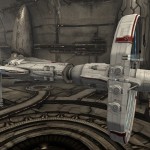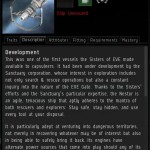Undisclosed location in Essence region,
POS owned by Aideron Technologies
Research log, 23rd of December, YC115. I will be attempting to disassemble external compression dishes of new Sisters of EVE warp drive. Both armor and external hull have been stripped. Dishes are made of unknown, possibly fullerene material and are consisting of two 120 degree arcs on both sides of the hull. Arcs are fitted with a grid of graviton emitters and are bearing the logo of Propel Dynamics. Power coupling which connects compression dishes to ships powergrid is of Caldari origin as well and is based on graviton technology. There is an electronic interface on the bottom of the starboard arc.
 Rox was still amazed how Sisters of EVE were able to convince several companies around New Eden, from all four factions that are currently at war with each other, to cooperate and provide components for the new ships. Astero was half disassembled already, and only vaguely reminded of it’s original shape. With the armor plates removed, most of the ship was made of light grey tritanium alloy, full of sticking I-beams, wires and tubes interconnecting all the ships systems. The drydock assembly array was normally used by Aideron Technologies to produce tech II ships, but it was just as useful to disassemble them and analyze their inner workings. Powerful stasis field kept the ship in place, while robotic arms removed components part by part, like a surgeon operating on a beating heart. Lukas was just outside the structure in a small Gallente shuttle. It was curious how the Sisters managed to move one of the crucial warp drive components from the inside of the ship to the external, ringlike structures outside of the ships hull. This mechnism is what made these ships able to use covert-ops cloaks, without the need for advanced quantum computers and huge cooling systems normally required to keep them operational.
Rox was still amazed how Sisters of EVE were able to convince several companies around New Eden, from all four factions that are currently at war with each other, to cooperate and provide components for the new ships. Astero was half disassembled already, and only vaguely reminded of it’s original shape. With the armor plates removed, most of the ship was made of light grey tritanium alloy, full of sticking I-beams, wires and tubes interconnecting all the ships systems. The drydock assembly array was normally used by Aideron Technologies to produce tech II ships, but it was just as useful to disassemble them and analyze their inner workings. Powerful stasis field kept the ship in place, while robotic arms removed components part by part, like a surgeon operating on a beating heart. Lukas was just outside the structure in a small Gallente shuttle. It was curious how the Sisters managed to move one of the crucial warp drive components from the inside of the ship to the external, ringlike structures outside of the ships hull. This mechnism is what made these ships able to use covert-ops cloaks, without the need for advanced quantum computers and huge cooling systems normally required to keep them operational.
Now attempting to remove the compression dish control electronics.
Robotic arm reached for a small piece of electronics attached to the bottom of the right arc. Reverse engineering these chips would probably yield insights into how exactly the drive operates. Just after the device was removed, the grid on both arcs began to glow. It was a dim blue light at first, but it was becoming brighter and more intense with every second.
Graviton levels are off the scale, removing the control circuitry from the drive has caused some kind of runaway reaction. Aura, signal the CEO, we might have to evacuate…
Rox did not finish his command. Half-disassembled Astero collapsed violently as if sucked by a black hole. The surrounding assembly array followed the implosion, pulling all the robotics, then the dry dock, and the assembly array hangar inside. Rox willed his shuttle away from the structure, but it was too late. The implosion suddenly reversed, releasing bright white light that enveloped the tiny craft, obliterating it instantly. The capsule, even though well shielded, crumbled under the intense pressure and heat. The ectoplasmic gel, which normally fills the capsule began to heat and then boil, making Rox twitch in pain. The pain was so intense, that he wanted to scream, but the tracheal tube would not allow it. You see, in space, no one can hear you scream. The blast damaged the surrounding Mobile Laboratories disabling half a dozen of them immediately, and it made the POS shield flicker for a several seconds. And then everything went dark. At least as far as Rox was concerned.
***
Lukas was expecting to see white light; it’s normal, because new clones never used their eyes before, making them very sensitive for the first couple of minutes.
Instead, his body was still in dull pain. But pain meant he was alive. The capsule did not feed anything into his brain socket, so it must have been seriously damaged.
– Lukas, can you hear me? – a voice said – Are you all right? Listen, we’ve received a notification that POS is under attack. Are you ok?
– I will live – Rox willed his thoughts through the barely operational FTL radio. – Lukas realized it was Razeu, who came to check up on the explosion.
– I am repairing your pod, it caught fire. You should be able to fly back to station… right now.
Rox was weak, and couldn’t feel his limbs, but willed the capsule into warp. Medical personel was waiting on the docking ramp already.
***
Undisclosed station in Essence region
Poteque Pharmaceuticals property
– We are sorry – said a doctor in a white robe – but we were unable to save your left arm.
– It’s all right – Rox replied – it will only have to do until next time I die.
– Well, technically yes. But until then, you have been given a Phanca arm prosthesis. We were also able to treat all 12 broken bones and severe burns that you’ve survived. We did what we could about the scars, but I’m afraid they will still be visible. Of course since you are an empyrean, all these are permanent, but for this clone only.
– How long until I can get back to work? – Rox inquired
– You should rest at least a week before going back into capsule. We will monitor your vitals, but they should remain stable. – doctor replied
– I would probably be more lucky if the pod blew. – Rox said
– Not quite – the doctor said – You will have to ask your technicians, because I don’t know the details, but it seems the explosion disabled all FTL comms for a moment. That would include brain scan from your capsule.
A shiver went down Rox’s spine. That was close!
– It seems I should’ve listened to that note and not tamper with it. – Rox said to himself.
– Excuse me? – asked the doctor









 Engineers at Project Crielere have proven, that this warp drive design creates too much interference for cloaking devices to operate properly at FTL speeds. First stealth generators used meta-materials to make the ship invisible in a specific band of electromagnetic spectrum (usually infrared or visible light). The ship was however still visible in other EM bands, for example microwave or gamma. Historically the second and currently used approach relies on a series of graviton pulse generators in order to create a gravity lens around the ship. This causes all electromagnetic radiation to be bent around the vessel, making it undetectable in any and all EM bands. The effect of the lens also shields the ship emissions by containing them inside the graviton bubble (using complete internal reflection). In order to keep the graviton generators synchronised and create a stable lens around the ship, ship’s computer must calculate the model of the gravity lens in real time. While the model is rather simple when the ship is stationary, it becomes increasingly difficult when the vessel begins to move. All matter that comes through the graviton bubble, including space dust and the ship thruster emissions causes unwanted interference, which ship’s computer needs to take into account when calculating the bubble model. However, when the ship enters the depleted vacuum bubble, the equations in the model change in an non-linear way, making it impossible for classic and photonic electronics to provide a solution.
Engineers at Project Crielere have proven, that this warp drive design creates too much interference for cloaking devices to operate properly at FTL speeds. First stealth generators used meta-materials to make the ship invisible in a specific band of electromagnetic spectrum (usually infrared or visible light). The ship was however still visible in other EM bands, for example microwave or gamma. Historically the second and currently used approach relies on a series of graviton pulse generators in order to create a gravity lens around the ship. This causes all electromagnetic radiation to be bent around the vessel, making it undetectable in any and all EM bands. The effect of the lens also shields the ship emissions by containing them inside the graviton bubble (using complete internal reflection). In order to keep the graviton generators synchronised and create a stable lens around the ship, ship’s computer must calculate the model of the gravity lens in real time. While the model is rather simple when the ship is stationary, it becomes increasingly difficult when the vessel begins to move. All matter that comes through the graviton bubble, including space dust and the ship thruster emissions causes unwanted interference, which ship’s computer needs to take into account when calculating the bubble model. However, when the ship enters the depleted vacuum bubble, the equations in the model change in an non-linear way, making it impossible for classic and photonic electronics to provide a solution. Engineers at Project Crielere eventually came up with an elegant quantum algorithm that can still provide a solution at FTL speeds, but it means a quantum computer hardware is required to solve the equations. This specialized hardware has been successfully installed into several classes of ships, including Recon cruisers and Blockade Runner industrials, but is generally unsuitable for most vessels, because it requires substantial customization. It also makes it nearly impossible to use on bigger ships, such as Black Ops battleships.
Engineers at Project Crielere eventually came up with an elegant quantum algorithm that can still provide a solution at FTL speeds, but it means a quantum computer hardware is required to solve the equations. This specialized hardware has been successfully installed into several classes of ships, including Recon cruisers and Blockade Runner industrials, but is generally unsuitable for most vessels, because it requires substantial customization. It also makes it nearly impossible to use on bigger ships, such as Black Ops battleships. By moving the warp drive polar dishes outside of the hull into a circular ring-like structure, Sanctuary engineers have removed the effect of depleted vacuum from the graviton bubble equations, making it possible to be calculated without specialized hardware. It is still unknown how exactly this circular structure actually creates depleted vacuum, because the electronics which does all the calculations is protected by advanced tamper-proof chips. Sisters of EVE also forbid the owners from tampering with the technology, voiding the warranty if external tampering is detected, and stating it that using the drive after it was modified will cause fatal injuries to those on board. I however believe it is only a matter of time until some intrepid hacker jailbreaks the electronic systems in the ring polar dishes, and reverse engineers the mathematics that make it work. This lets me believe that by applying this technology to a battleship-class hull could allow even the biggest of vessels to use cloaking technology at FTL speeds. It opens the possibility for The Sanctuary to develop a covert battleship vessel as well, which is currently unconfirmed, but theoretically possible.
By moving the warp drive polar dishes outside of the hull into a circular ring-like structure, Sanctuary engineers have removed the effect of depleted vacuum from the graviton bubble equations, making it possible to be calculated without specialized hardware. It is still unknown how exactly this circular structure actually creates depleted vacuum, because the electronics which does all the calculations is protected by advanced tamper-proof chips. Sisters of EVE also forbid the owners from tampering with the technology, voiding the warranty if external tampering is detected, and stating it that using the drive after it was modified will cause fatal injuries to those on board. I however believe it is only a matter of time until some intrepid hacker jailbreaks the electronic systems in the ring polar dishes, and reverse engineers the mathematics that make it work. This lets me believe that by applying this technology to a battleship-class hull could allow even the biggest of vessels to use cloaking technology at FTL speeds. It opens the possibility for The Sanctuary to develop a covert battleship vessel as well, which is currently unconfirmed, but theoretically possible.